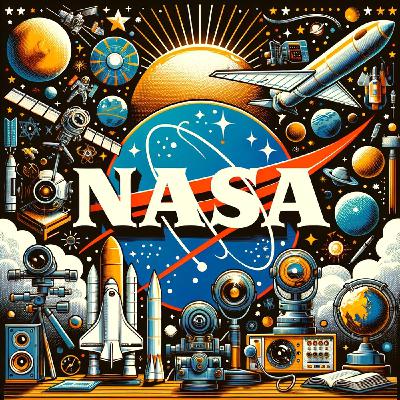Lunar Ambitions and Budget Battles: The Uncertain Future of NASA's Artemis Program
Update: 2025-09-26
Description
This week’s biggest NASA headline is the Artemis II crewed mission update. After their successful uncrewed Artemis I circumlunar flight, NASA confirmed Artemis II is on track to launch by April 2026, marking the first time in decades that American astronauts will travel around the Moon. Artemis II’s four-person crew will spend ten days circling the lunar surface, a critical step toward a sustained human presence on the Moon and, eventually, Mars. According to Lakiesha Hawkins, NASA’s acting deputy associate administrator for Exploration Systems, “Every risk we retire with Artemis II means a safer path to Mars for humanity.” The Artemis program isn’t just about space travel; it is meant to inspire innovation, boost STEM education, and stimulate the economy by creating contracts and partnerships with American companies and international allies.
But behind the scenes, NASA faces unprecedented budget turbulence. The House Appropriations Committee advanced a budget offering $24.8 billion for 2026—holding steady, despite White House proposals to slash science funding by nearly half and cut a quarter of NASA’s overall budget. Cuts this severe would force the termination of more than 40 missions, furlough nearly a third of NASA’s workforce, and halt key projects at the Goddard Space Flight Center and Jet Propulsion Lab. The Planetary Society described the White House proposal as an “extinction-level event” for NASA science. Although Congress is pushing back hard to defend these programs, there’s ongoing uncertainty; the final budget likely won’t be signed by the crucial September 30th deadline.
Leadership has also seen shakeups. President Trump directed current acting NASA Administrator Janet Petro to step down, temporarily appointing Secretary of Transportation Sean Duffy to the top NASA post, marking the first time NASA will be run by the head of another federal department. This move is intended as stopgap leadership until a new, permanent administrator is found.
On the bright side, NASA just welcomed its 2025 class of all-American astronaut candidates, who will begin training immediately. These ten selectees represent the next generation of explorers and will be eligible for future Artemis and space station missions.
For American citizens, these shifts mean both pride in the nation’s renewed lunar ambitions and concern for the future of space science and U.S. leadership in discovery. Businesses and contractors tied to exploration and technology may find contracts and research in jeopardy if budgets aren’t stabilized. States hosting major NASA centers could face layoffs and economic ripple effects. Around the world, NASA’s ability to maintain its global partnerships in space hinges on sustained funding and stable leadership.
Looking ahead, eyes are on the Congressional appropriations process and the Artemis II launch schedule. NASA fans and concerned citizens can make their voices heard by reaching out to their representatives—organizations like The Planetary Society are calling for continued public engagement to protect U.S. space science.
To stay updated, check out NASA’s official Artemis and news websites, and tune in to upcoming livestreams and public forums. If you care about the future of space exploration, now’s the time to speak up and show support.
Thank you for tuning in to the NASA update. Remember to subscribe for weekly insights. This has been a quiet please production, for more check out quiet please dot ai.
For more http://www.quietplease.ai
Get the best deals https://amzn.to/3ODvOta
This content was created in partnership and with the help of Artificial Intelligence AI
But behind the scenes, NASA faces unprecedented budget turbulence. The House Appropriations Committee advanced a budget offering $24.8 billion for 2026—holding steady, despite White House proposals to slash science funding by nearly half and cut a quarter of NASA’s overall budget. Cuts this severe would force the termination of more than 40 missions, furlough nearly a third of NASA’s workforce, and halt key projects at the Goddard Space Flight Center and Jet Propulsion Lab. The Planetary Society described the White House proposal as an “extinction-level event” for NASA science. Although Congress is pushing back hard to defend these programs, there’s ongoing uncertainty; the final budget likely won’t be signed by the crucial September 30th deadline.
Leadership has also seen shakeups. President Trump directed current acting NASA Administrator Janet Petro to step down, temporarily appointing Secretary of Transportation Sean Duffy to the top NASA post, marking the first time NASA will be run by the head of another federal department. This move is intended as stopgap leadership until a new, permanent administrator is found.
On the bright side, NASA just welcomed its 2025 class of all-American astronaut candidates, who will begin training immediately. These ten selectees represent the next generation of explorers and will be eligible for future Artemis and space station missions.
For American citizens, these shifts mean both pride in the nation’s renewed lunar ambitions and concern for the future of space science and U.S. leadership in discovery. Businesses and contractors tied to exploration and technology may find contracts and research in jeopardy if budgets aren’t stabilized. States hosting major NASA centers could face layoffs and economic ripple effects. Around the world, NASA’s ability to maintain its global partnerships in space hinges on sustained funding and stable leadership.
Looking ahead, eyes are on the Congressional appropriations process and the Artemis II launch schedule. NASA fans and concerned citizens can make their voices heard by reaching out to their representatives—organizations like The Planetary Society are calling for continued public engagement to protect U.S. space science.
To stay updated, check out NASA’s official Artemis and news websites, and tune in to upcoming livestreams and public forums. If you care about the future of space exploration, now’s the time to speak up and show support.
Thank you for tuning in to the NASA update. Remember to subscribe for weekly insights. This has been a quiet please production, for more check out quiet please dot ai.
For more http://www.quietplease.ai
Get the best deals https://amzn.to/3ODvOta
This content was created in partnership and with the help of Artificial Intelligence AI
Comments
In Channel





